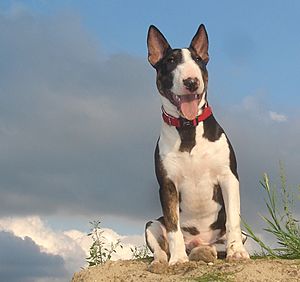Miniature Bull Terrier facts for kids

Bull Terrier (left) and Miniature Bull Terrier
|
|||||||||||||||||||||
| Other names | Mini Bull | ||||||||||||||||||||
|---|---|---|---|---|---|---|---|---|---|---|---|---|---|---|---|---|---|---|---|---|---|
| Origin | England | ||||||||||||||||||||
|
|||||||||||||||||||||
|
|||||||||||||||||||||
| Domestic dog (Canis lupus familiaris) | |||||||||||||||||||||
The Miniature Bull Terrier is a special type of dog breed. It comes from older dog breeds. These include the extinct English White Terrier, the Dalmatian, and the Bulldog. People first wrote about this dog in 1872. It was in a book called The Dogs of British Island.
Contents
About Miniature Bull Terriers
What They Look Like
Miniature Bull Terriers have short, fine, and shiny coats. Their fur lies very close to their skin. They can be white, white with another color, or fully colored. However, blue or liver-colored coats are not preferred. These dogs do not need much grooming.
In the early 1900s, a dog's weight decided if it was a Miniature Bull Terrier. This made some dogs too small. They looked more like a Chihuahua than a Bull Terrier. So, in the 1970s, they set a height limit instead. Miniature Bull Terriers must be under 14 inches tall. They are usually not smaller than 10 inches. Their weight should match their height. They often weigh between 20 and 35 pounds.
Miniature Bull Terriers have a strong build. They have very muscular shoulders and a full body. Their head is often called "egg-shaped." It is flat on top with a Roman nose. Their eyes are triangular and set close together. Their ears stand straight up. The tail is carried straight out, not curled up.
Their Personality
Miniature Bull Terriers are loving dogs. Like many terrier breeds, they can be stubborn sometimes. But they make great pets, even for people with small homes.
These dogs are known for being brave. Even though they are small, they will challenge bigger dogs. Owners can train them well to avoid fights. They are very energetic and playful. They love people, but owners should be careful around other dogs.
Miniature Bull Terriers need little grooming. A quick brushing a few times a week is enough. If they have white fur, use sunscreen on their face, ears, or stomach. This is important when they are outside, especially in summer. It helps prevent sunburn and skin problems.
Training Your Mini Bull Terrier
Miniature Bull Terriers are independent and can be stubborn. They need a lot of training, especially when they are young. It is important to help them meet many people and other dogs early on. This is called socialization. They also need to learn to obey commands early in their lives.
As puppies, they are very energetic and can play for a long time. But as they get older, they become less energetic. Owners must make sure they get enough exercise. They also need a good diet to avoid becoming overweight.
Health Concerns
Miniature Bull Terriers can have some health problems. People thinking about getting one should know about these issues.
- Deafness: Some Miniature Bull Terriers can be born deaf. They might be deaf in one ear or both. Dogs that are deaf should not be used for breeding. This is because deafness can be passed down to puppies. There are tests for puppies to check their hearing before they are sold.
- Lethal Acrodermatitis (LAD): This is a serious genetic disease. It usually appears in puppies around four weeks old. Affected puppies' black fur may look lighter. This is due to a lack of zinc. It causes skin problems and affects their body systems. Sadly, it leads to an early death. A DNA test can now check breeding dogs. This helps ensure puppies are born free of LAD.
- Knee Problems: Miniature Bull Terriers can have a knee problem called luxating patella. This is common in small dogs. It means the kneecap slips out of place. Surgery can often fix this problem.
- Kidney Diseases: They can also get kidney diseases. These include Polycystic kidney disease (PKD) and Bull Terrier hereditary nephritis (BTHN). A special ultrasound scan can find PKD. A urine test can find BTHN. Dogs with good test results are considered clear of the disease. Testing breeding dogs helps prevent these diseases in puppies.
- Eye Problems: A common eye problem is primary lens luxation (PLL). This disease usually affects dogs between 2 and 7 years old. A DNA test can tell if a dog is clear, a carrier, or affected by PLL. This test helps breeders make good choices.
- Heart Diseases: Some Miniature Bull Terriers can have heart problems. These include Aortic valve stenosis and mitral valve dysplasia. A special heart scan can diagnose these conditions.
- Skin Issues: Skin problems can also happen. These include hot spots, allergic reactions, and hives.
Miniature Bull Terriers usually live for 10 to 14 years.
History
When the Bull Terrier breed first started in 19th century England, it was about the same size as the Miniature Bull Terrier today. The Miniature Bull Terrier became an official breed with the American Kennel Club (AKC) on May 14, 1991. This became effective on January 1, 1992.
Interbreeding
Sometimes, a Miniature Bull Terrier and a Bull Terrier are bred together. This is called interbreeding. It is allowed for a short time in Australia, New Zealand, and the United Kingdom. This is done to help reduce the eye problem called Primary Lens Luxation in Miniature Bull Terriers. Bull Terriers do not carry the gene for this problem. So, their puppies will not have the disease.


